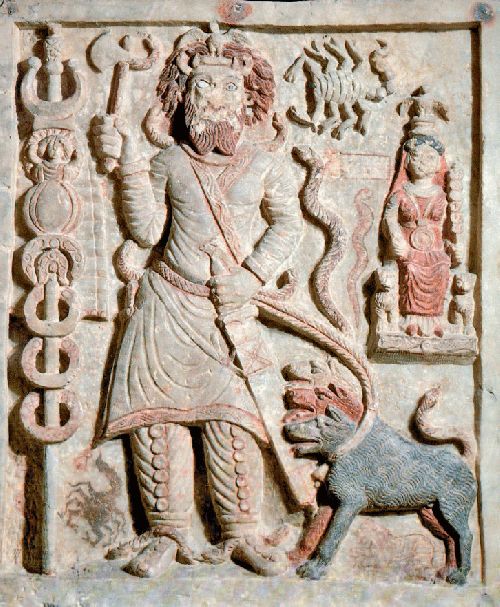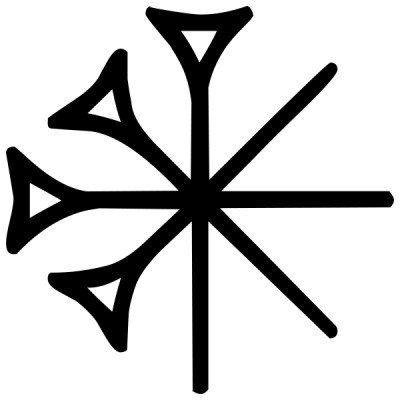
| ANUNNAKI THE GODS
Akkadian cylinder seal from sometime around 2300 BC or thereabouts depicting the deities Inanna, Utu, Enki, and Isimud The Anunnaki are a group of deities first attested during the reign of Gudea (c. 2144 – 2124 BC) and the Third Dynasty of Ur. Originally, the Anunnaki appear to have been heavenly deities with immense powers, who were believed to "decree the fates of mankind". Later they became regarded as chthonic Underworld deities. They are chiefly mentioned in literary texts and very little evidence to support the existence of any cult of them has yet been unearthed. This is likely due to the fact that each member of the Anunnaki had his or her own individual cult, separate from the others. Similarly, no representations of the Anunnaki as a group have yet been discovered, although a few depictions of its individual members have been identified. Another group of deities are the Igigi, who are first attested from the Old Babylonian Period (c. 1830 BC – c. 1531 BC). The name Igigi seems to have originally been applied to the ten "great gods", but it later came to refer to all the gods of Heaven collectively. In some instances, the terms Anunnaki and Igigi are used synonymously.
The majority of Sumerian deities belonged to a classification called the Anunna (“[offspring] of An”), whereas seven deities, including Enlil and Inanna, belonged to a group of “underworld judges" known as the Anunnaki (“[offspring] of An” + Ki). During the Third Dynasty of Ur, the Sumerian pantheon was said to include sixty times sixty (3600) deities.
Anunnaki, the group of seven deities probably included the "seven gods who decree": Anu, Enlil, Enki, Ninhursag, Nanna, Utu, and Inanna.
Sumerian afterlife :
The Sumerian afterlife was a dark, dreary cavern located deep below the ground, where inhabitants were believed to continue "a shadowy version of life on earth". This bleak domain was known as Kur, and was believed to be ruled by the goddess Ereshkigal.
The souls in Kur were believed to eat nothing but dry dust and family members of the deceased would ritually pour libations into the dead person's grave through a clay pipe, thereby allowing the dead to drink. Nonetheless, there are assumptions according to which treasures in wealthy graves had been intended as offerings for Utu and the Anunnaki, so that the deceased would receive special favors in the underworld. During the Third Dynasty of Ur, it was believed that a person's treatment in the afterlife depended on how he or she was buried; those that had been given sumptuous burials would be treated well, but those who had been given poor burials would fare poorly, and were believed to haunt the living.
The entrance to Kur was believed to be located in the Zagros mountains in the far east. It had seven gates, through which a soul needed to pass. The god Neti was the gatekeeper. Ereshkigal's sukkal, or messenger, was the god Namtar. Galla were a class of demons that were believed to reside in the underworld; their primary purpose appears to have been to drag unfortunate mortals back to Kur. They are frequently referenced in magical texts, and some texts describe them as being seven in number. Several extant poems describe the galla dragging the god Dumuzid into the underworld. The later Mesopotamians knew this underworld by its East Semitic name: Irkalla. During the Akkadian Period, Ereshkigal's role as the ruler of the underworld was assigned to Nergal, the god of death. The Akkadians attempted to harmonize this dual rulership of the underworld by making Nergal Ereshkigal's husband.
Nergal Triad of Heaven :
The three most important deities in the Mesopotamian pantheon during all periods were the deities An, Enlil, and Enki. An was identified with all the stars of the equatorial sky, Enlil with those of the northern sky, and Enki with those of the southern sky. The path of Enlil's celestial orbit was a continuous, symmetrical circle around the north celestial pole, but those of An and Enki were believed to intersect at various points.
1. An / Anu :
Image Major cult centers : Eanna temple in Uruk
Celestial body : Equatorial sky
Associated color : Luludanitu; ensemble of red, white and black
Details :
An (in Sumerian), later known as Anu or Ilu (in Akkadian), is the supreme God and "prime mover in creation", embodied by the sky. He is the first and most distant ancestor, theologically conceived as the God of Heaven in its "transcendental obscurity". All the deities were believed to be the offspring of An and his consort Ki (cf. Anunnaki). While An was the utmost God, at least by the time of the earliest written records the cult was largely devoted to Enlil.
2. Ashnan :
Ashnan is the goddess of grain. In the Sumerian poem The Dispute between Cattle and Grain, she and her sister Lahar are created by the Anunnaki to provide them with food. They produce large amounts of food, but become drunk with wine and start to quarrel, so Enki and Enlil intervene, declaring Ashnan the victor.
3. Lahar :
Lahar is a goddess of cattle. In the Sumerian poem The Dispute between Cattle and Grain, she and her sister Ashnan are created by the Anunnaki to provide them with food. They produce large amounts of food, but become drunk with wine and start to quarrel, so Enki and Enlil intervene, declaring Ashnan the victor.
4. Enlil :
Enlil was the god of air, wind, and storm. He was also the chief god of the Sumerian pantheon and the patron deity of the city of Nippur. His primary consort was Ninlil, the goddess of the south wind, who was one of the matron deities of Nippur and was believed to reside in the same temple as Enlil. Ninurta was the son of Enlil and Ninlil. He was worshipped as the god of war, agriculture, and one of the Sumerian wind gods. He was the patron deity of Girsu and one of the patron deities of Lagash.
5. Enki :
Enki was god of freshwater, male fertility, and knowledge. His most important cult center was the E-abzu temple in the city of Eridu. He was the patron and creator of humanity and the sponsor of human culture. His primary consort was Ninhursag, the Sumerian goddess of the earth. Ninhursag was worshipped in the cities of Kesh and Adab.
6. Inanna :
Inanna was the Sumerian goddess of love, beauty, and warfare. She was the divine personification of the planet Venus, the morning and evening star. Her main cult center was the Eanna temple in Uruk, which had been originally dedicated to An. The Sumerians had more myths about Inanna than any other deity. Many of the myths involving her revolve around her attempts to usurp control of the other deities' domains.
7. Utu :
Utu was god of the sun, whose primary center of worship was the E-babbar temple in Sippar. Utu was principally regarded as a dispenser of justice; he was believed to protect the righteous and punish the wicked. Nanna was god of the moon and of wisdom. He was the father of Utu and one of the patron deities of Ur.
8. Ereshkigal :
Ereshkigal was the goddess of the Sumerian Underworld, which was known as Kur. She was Inanna's older sister. The gatekeeper of the underworld was the god Neti.
9. Nammu :
Nammu was a goddess representing the primeval waters (Engur), who gave birth to An (heaven) and Ki (earth) and the first deities; while she is rarely attested as an object of cult, she likely played a central role in the early cosmogony of Eridu, and in later periods continued to appear in texts related to exorcisms. An was the ancient Sumerian god of the heavens. He was the ancestor of all the other major deities and the original patron deity of Uruk.
Most major gods had a so-called sukkal, a minor deity serving as their vizier, messenger or doorkeeper.
Yazdâni Principal beliefs and Anunnaki :
In Yazdâni theologies, an absolute pantheistic force (Hâk or Haqq) encompasses the whole universe. It binds together the cosmos with its essence, and has entrused the universe the heft sirr (the "Heptad", "Seven Mysteries", "Seven Angels"), who sustain universal life and can incarnate in persons, bâbâ ("Gates" or "Avatar"). These seven emanations are comparable to the seven Anunnaki aspects of Anu of ancient Mesopotamian theology, and they include Melek Taus (the "Peacock Angel" or "King"), who is the same as the ancient god Dumuzi son of Enki and the main deity in Yazidi theology, and Shaykh Shams al-Din, "the sun of the faith", who is Mithra.
These religions continue the theology of Mesopotamian religions under a Zoroastrian influence, and expressed through an Arabic and Persianate Sufi lexicon.
Seven divine beings :
The principal feature of Yazdânism is the belief in seven benevolent divine beings that defend the world from an equal number of malign entities. While this concept exists in its purest form in Yârsânism and Yazidism, it evolves into "seven saints/spiritual persons", which are called "Yedi Ulu Ozan" in Alevism. Another important feature of these religions is a doctrine of reincarnation. The belief in reincarnation has been documented among the Nusayri (Shamsi Alawites) as well.
The Yazidis believe in a single God as creator of the world, which he has placed under the care of these seven “holy beings” or angels, whose “chief” (archangel) is Melek Taus, the “Peacock Angel”. The Peacock Angel, as world-ruler, causes both good and bad to befall individuals, and this ambivalent character is reflected in myths of his own temporary fall from God’s favor, before his remorseful tears extinguished the fires of his hellish prison and he was reconciled with God.
Melek Taus is sometimes identified by Muslims and Christians with Shaitan (Satan). Yazidis, however, strongly dispute this, considering him to be the leader of the archangels, not a fallen angel. According to Christine Allison :
The Yazidis of Kurdistan have been called many things, most notoriously “devil-worshippers”, a term used both by unsympathetic neighbours and fascinated Westerners. This sensational epithet is not only deeply offensive to the Yazidis themselves, but quite simply wrong.
Because of this connection to the Sufi Iblis tradition, some followers of Christianity and Islam equate the Peacock Angel with their own unredeemed evil spirit Satan, which has incited centuries of persecution of the Yazidis as ‘devil worshippers’. Persecution of Yazidis has continued in their home communities within the borders of modern Iraq. In August 2014 the Yazidis were targeted by the Islamic State of Iraq and the Levant, or ISIL, in its campaign to ‘purify’ Iraq and neighboring countries of non-Islamic influences.
Other Anunnaki Links :
|
_-_EnKi_(Sumerian).jpg)

